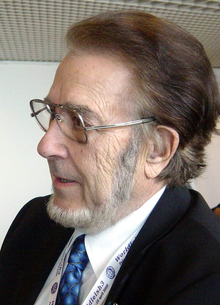Jean-Antoine Rioux
Jean-Antoine Rioux | |
|---|---|
 Jean-Antoine Rioux | |
| Born | 1925 |
| Died | 2017 |
| Nationality | French |
| Alma mater | University of Montpellier |
| Scientific career | |
| Fields | Parasitology, Entomology |
| Institutions | University of Montpellier |
Jean-Antoine Rioux (1925–2017) was a French parasitologist, mainly a specialist of leishmaniasis. He coined the term ecoepidemiology for a discipline combining concepts of ecology and epidemiology to understand parasite transmission patterns and processes. He was a professor at the University of Montpellier and one of the founders of the Société Française de Parasitologie in 1962.[1]
Scientific career

Jean-Antoine Rioux worked on several parasitological diseases, including malaria, plague, schistosomiasis, and leishmaniasis. He led teams in the field in France (Camargue, Languedoc, Roussillon, Cévennes, Corsica) and various countries including Iran, Chad, Tunisia, and Morocco.[1]
Jean-Antoine Rioux was also a botanist and the Director of the jardin des plantes de Montpellier,[1] a historic botanical garden and arboretum located in Montpellier, France.
Taxa named in his honour

Many taxa were named in the honour of Jean-Antoine Rioux by his colleagues. The list of species includes: Adelina riouxi Levine, 1977 (Coccidia, Adeleidae), Amphinomia riouxii Quézel, 1959 (Rosales, Leguminosae), Culicoides riouxi Callot & Krémer, 1961 (Diptera, Ceratopogonidae), Empidomermis riouxi Doucet, Laumont & Bain, 1979 (Nematoda, Mermithidae), Hystrichopsylla talpae riouxi Beaucournu & Rosin, 1977 (Siphonaptera, Hystrichopsyllidae), Longicollum riouxi Golvan, 1969 (Acanthocephala, Pomphorhynchidae), Phlebotomus (Paraphlebotomus) riouxi Depaquit, Léger & Killick-Kendrick, 1998 (Diptera, Psychodidae), Pseudorhabdosynochus riouxi (Oliver, 1986) Kritsky & Beverley-Burton, 1986 (Monogenea, Diplectanidae). The genus Riouxgolvania Bain & Brunhes, 1968 (Nematoda, Muspiceidae) honours both Jean-Antoine Rioux and Yves-Jean Golvan, two French parasitologists.[1] The subgenus Riouxomyia Depaquit, Blavier & Randrianambinintsoa, 2019 has been created for sandflies (Diptera, Phlebotominae).[2]
Scientific collection
Jean-Antoine Rioux collected un impressive number of specimens, mainly phlebotomes, during his career. His collection includes more than 130,000 specimens coming from 10 countries: France, Italy, Spain, Algeria, Tunisia, Morocco, Yemen, Syria, Sudan,and Republic of Congo. The collection is now curated by the University of Reims Champagne-Ardenne in France.[3]
Selected publications
The most cited paper by Jean-Antoine Rioux is his classification of Leishmania in 1990.[4]
External links
References
- ^ a b c d Houin, René; Léger, Nicole; Dupouy-Camet, Jean; Bastien, Patrick; Luffau, Gérard (2018). "In memoriam Professor Jean-Antoine Rioux (1925-2017)". Parasite. 25: 13. doi:10.1051/parasite/2018012. ISSN 1776-1042. PMC 5849416.

- ^ Blavier, Antoine; Laroche, Laetitia; Randrianambinintsoa, Fano José; Lucas, Vincent; Gantier, Jean-Charles; Léger, Nicole; Robert, Vincent; Depaquit, Jérôme (2019). "Phlebotomine sandflies (Diptera, Psychodidae) from the Ankarana tsingy of northern Madagascar: inventory and description of new taxa". Parasite. 26: 38. doi:10.1051/parasite/2019039. ISSN 1776-1042. PMC 6601424. PMID 31259684.
- ^ Depaquit J. Sur la collection de phlébotomes (Diptera: Psychodidae) du Professeur Jean-Antoine Rioux. MTSI [Internet]. 17 sept.2021 Available from: http://revuemtsi.societe-mtsi.fr/index.php/bspe-articles/article/view/127 Archived 2021-12-01 at the Wayback Machine

- ^ Rioux, J. A.; Lanotte, G.; Serres, E.; Pratlong, F.; Bastien, P.; Perieres, J. (1990). "Taxonomy of Leishmania. Use of isoenzymes. Suggestions for a new classification". Annales de Parasitologie Humaine et Comparée. 65 (3): 111–125. doi:10.1051/parasite/1990653111. ISSN 0003-4150. PMID 2080829. Archived from the original on 2018-03-31. Retrieved 2018-03-30.

